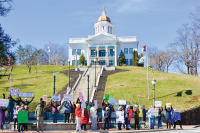We’ve been here before … sort of

It’s funny how you can hear a story your entire life but don’t see its relevance until it smacks you in the face.
Since childhood, my parents have told me the tale of the Hong Kong flu (H3N2 virus) during the winter of 1968. They weren’t sure where they contracted it initially. At the time, my dad was a student at Mars Hill College and worked as a short order cook in the student center. My mom was in her first year teaching public school. Both places were most likely rampant with germs.
It started with a small cough and within no time, they were both horribly ill with chest pain, deep coughing, chills and high fevers. They did not eat for a couple days until one night, my mom crawled from the bed to the kitchen. On her hands and knees, she managed to put two russet potatoes in the oven to bake.
After a week, they began to recover, although it took time to regain complete strength. They were in their twenties, their young bodies able to fight off the wretched virus.
Until lately, my parents’ Hong Kong flu story was merely another chapter in their long book of life. With decades upon decades of marriage, they shared many stories like this one. But now, in the middle of a similar pandemic, the narrative offers greater implication.
Recently someone mentioned the pandemic of the late 1960s being similar to the one we’re experiencing now. Like the proverbial light bulb, a vision of my young parents delirious with illness flashed in my mind. During COVID-19, my dad hasn’t mentioned the Hong Kong flu, so I brought it up the other night, reminding him that he’s already experienced this once in his lifetime.
Related Items
My dad agreed that what he experienced during the Hong Kong flu episode was one of the sickest times of his life, but he touched on the key disparity between then and now. In 1968, there was no internet or 24-hour news cycle. There was no social media or texting or constant update in case numbers and deaths. While he knew from the radio and nightly news the Hong Kong flu was a global pandemic, the true focus of the illness was within his own home and community. There were no restrictions or business closures. When individuals and families recovered, they carried on with regular life. The mass hysteria was much less.
The first recorded case of H3N2 was on July 13, 1968, in Hong Kong, but there is a possibility the virus began in mainland China. This strain is of animal origin. By September of 1968, the virus reached India, the Philippines, northern Australia and Europe. That same month, it entered the United States by troops returning to California from the Vietnam War. It became widespread in the United States by December 1968 and reached Africa, Japan and South America by 1969.
In Berlin, the excessive number of deaths resulted in corpses being stored in subway tunnels, while in West Germany, garbage collectors buried the dead, due to an insufficient number of undertakers. Manufacturing, postal services and train systems suffered throughout Europe, Asia and the United States.
According to the CDC, one million deaths were reported worldwide and 100,000 of those being Americans. The illness was allowed to spread without restrictions on economic or social activity, until a vaccine became available some four months after it started. While individuals wore masks and stayed home while sick, social distancing was not enforced. The Hong Kong flu returned the following flu season (1969/1970) resulting in a second, deadlier wave.
While there are clear similarities between the Hong Kong flu and COVID-19, it’s not quite apples to apples. Perhaps most notably is that any strain of flu is more easily managed than a novel virus such as COVID-19. Doctors and scientists first created a viable flu vaccine in the 1940s, so when they must create a vaccine for a new type of flu, they are not starting from ground zero, making the development and availability much quicker.
During the 1968 Hong Flu pandemic and the 1957 flu pandemic, vaccines were created in a short time frame. Even though these strains still circulate as part of seasonal flu illnesses, herd immunity has decreased the threat monumentally. With COVID-19, it seems doctors and scientists are starting from scratch. It also seems there is more red tape and bureaucracy than in the early to mid-twentieth century, leading to delays in the creation and accessibility of a vaccine.
It seems bizarre that in 2020, we’re dealing with a completely novel virus, but isn’t that the way? Viruses are ruthless. Once the human host becomes quasi-resilient to one type, another will spawn and rear its ferocious head. The positive is that when we create a vaccine for COVID-19, we’ll have a prototype for similar viruses in the future.
In the meantime, do what you can to stay safe while maintaining your mental health. Like my dad said, the mass panic was less in the 1960s because their access to news and statistics was limited. Help yourself by staying off social media and limiting your time watching TV. It’s not necessary to watch coverage all day or routinely check case numbers. Instead, take a walk, pick up an instrument or a book, dig in your garden or write a letter to a loved one. Believe me, you’ll be so glad you did.
(Susanna Shetley is a writer, editor and digital media specialist. This email address is being protected from spambots. You need JavaScript enabled to view it.)









